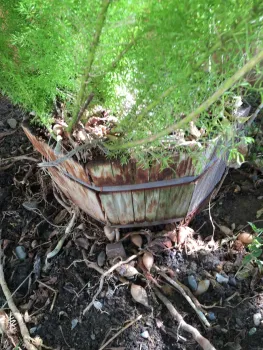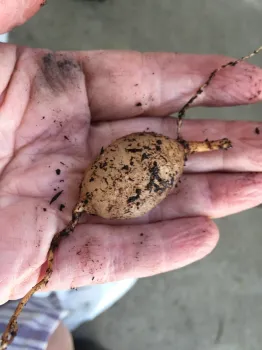I recently had to replace a small section of sidewalk next to my garage. Not sure what caused it, but it had become uneven, leaving a dangerous lip I could easily have tripped over. Since I am not the most coordinated person, able to trip over throw rugs, hoses, and my own feet, I arranged for the corrective concrete work to be done. As part of the process, an old wooden planter, containing an asparagus fern, had to be moved.
The plant had been in that same location for over 20 years, watered when I thought about it, but ignored most of the year. It had obviously become pot bound, with the planter splitting apart from the overcrowded roots. One of the concrete workers got it up for me. The roots that had broken through the bottom of the planter extended into the ground. Many tiny white shapes that resembled really small potatoes were attached to the roots. I searched in my newest book, “Plant Propagation”, from the American Horticultural Association, to figure out what to do with them. This excellent resource book called these small shapes “bulblets”. It suggested removing each one and planting each in individual containers of soil.


I did further research online, and learned that what I had been calling an “asparagus fern” was not its true name! My long-lived plant is actually a “Foxtail Fern”, Asperigus meyeri. This plant is originally from South Africa, is part of the lily family, and thrives in the Mediterranean area. A problem arises when it is mislabeled as an “asparagus fern”, the Asparagus sprengeri, because the true asparagus fern is considered invasive. It is classified as a weed in Florida, Hawaii, New Zealand, and Australia! It looks similar to the foxtail, but it contains spines, poisonous red berries, and spreads by spores. A quick search of my garden revealed that I had two of the bad guy Asparagus sprengeri in pots. I have carefully removed them, placing all the offensive fronds into a large trash bag, and cleaning off my garden pruners with rubbing alcohol so I did not accidentally spread the invasive spores around.
I am enjoying my newly smooth sidewalk, and have moved the old wooden planter under a nearby tree so it can happily be ignored for another 20 years! I have planted my bulblets into individual pots, and will carefully tend them. Hoping for a bumper crop of foxtail ferns, with extras to share at the next Master Gardeners plant exchange!

